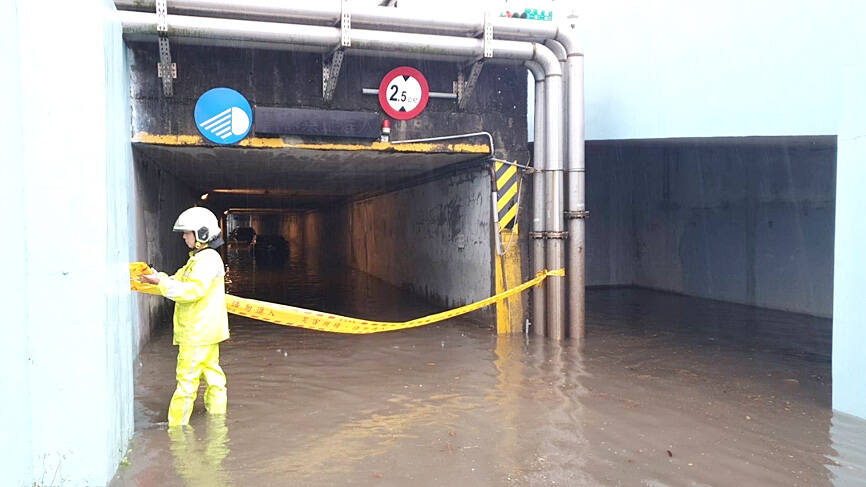Heavy downpours in northern Taiwan yesterday morning caused flooding, but did little to fill Shihmen Reservoir (石門水庫) in Taoyuan, with officials warning that the region could be facing a historic water shortage this year.
The Water Resources Agency’s Northern Region Water Resources Branch said the rain added a modest amount of water to the reservoir, which was at 24.56 percent capacity as of noon.
Since the rain fell mostly in the lower reaches of the reservoir’s catchment area, the office immediately contacted the Shihmen and Taoyuan management offices to suspend water supply farms in the region.

Photo copied by CNA
The retention rate at Shihmen Reservoir dropped to 24.2 percent on Wednesday, lower than levels in 2021, which were the lowest in a century.
Taoyuan Mayor Simon Chang (張善政) told reporters on Wednesday that the lower retention rate in 2021 was because the government withheld water from farms, which had left a lot of land fallow.
Peak irrigation has passed and the next major water usage period would not be until the heading stage at the end of next month, Chang said.
If the plum rains arrive by that time, the water shortage would be solved, but if it does not and water retention at the reservoir does not improve, farmers would have to start planning for the worst, he said.
Supply from the Bansin Water Treatment Plant had been switched to Feitsui Reservoir (翡翠水庫), while the Taoyuan Department of Economic Development is preparing 300 wells, eight water storage centers and 700 water towers to combat the water shortage, he said.
People should refrain from washing vehicles and windows, or conducting other activities that use large amounts of water, Chang said.
Meanwhile, the Taipei Feitsui Reservoir Administration said the greater Taipei area is unlikely to have a water shortage in the next three months after yesterday’s heavy downpour replenished the Feitsui Reservoir.
The catchment area had accumulated about 38.7mm of rainfall — or more than 10 million cubic meters — as of 9:50am yesterday, the agency said.
The amount is estimated to be equivalent to the storage capacity of the Sinshan Reservoir (新山水庫) in Keelung, it said.
The downpour had supplied the greater Taipei area with four days of water, it said.
The Feitsui Reservoir, the largest in Taiwan, was at 68 percent capacity, it added.
The Central Weather Administration said that the heaviest rainfall was at about 7am yesterday, with Taipei’s Nangang District (南港) and Wugu District (五股) in New Taipei City the most affected, each receiving about 70mm per hour, causing flooding in some areas.
Gene You (游景雲), director of National Taiwan University’s Hydrotech Research Institute, said that severe flooding was not a systemic problem, but was due to parts of the drainage system not coping.
The precipitation came before an annual review of drainage systems, usually conducted in May, You said.
City governments should consider establishing smaller retention areas in response to climate change, he said.
Asked if drainage systems should be checked earlier in the year, You said practicality must be considered, as while the schedule could be changed, drains would become cluttered with litter and trash before the rainy season.
Sudden, extreme downpours are increasingly regular and urban drainage systems should be upgraded, he said, citing Taipei’s system, which was designed to handle 78mm per hour, but should be increased to 88mm per hour.

TRAGEDY STRIKES TAIPEI: The suspect died after falling off a building after he threw smoke grenades into Taipei Main Station and went on a killing spree in Zhongshan A 27-year-old suspect allegedly threw smoke grenades in Taipei Main Station and then proceeded to Zhongshan MRT Station in a random killing spree that resulted in the death of the suspect and two other civilians, and seven injured, including one in critical condition, as of press time last night. The suspect, identified as a man surnamed Chang Wen (張文), allegedly began the attack at Taipei Main Station, the Taipei Fire Department said, adding that it received a report at 5:24pm that smoke grenades had been thrown in the station. One man in his 50s was rushed to hospital after a cardiac arrest

SAFETY FIRST: Double the number of police were deployed at the Taipei Marathon, while other cities released plans to bolster public event safety Authorities across Taiwan have stepped up security measures ahead of Christmas and New Year events, following a knife and smoke bomb attack in Taipei on Friday that left four people dead and 11 injured. In a bid to prevent potential copycat incidents, police deployments have been expanded for large gatherings, transport hubs, and other crowded public spaces, according to official statements from police and city authorities. Taipei Mayor Chiang Wan-an (蔣萬安) said the city has “comprehensively raised security readiness” in crowded areas, increased police deployments with armed officers, and intensified patrols during weekends and nighttime hours. For large-scale events, security checkpoints and explosives

PUBLIC SAFETY: The premier said that security would be tightened in transport hubs, while President Lai commended the public for their bravery The government is to deploy more police, including rapid response units, in crowded public areas to ensure a swift response to any threats, President William Lai (賴清德) said yesterday after a knife attack killed three people and injured 11 in Taipei the previous day. Lai made the remarks following a briefing by the National Police Agency on the progress of the investigation, saying that the attack underscored the importance of cooperation in public security between the central and local governments. The attack unfolded in the early evening on Friday around Taipei Main Station’s M7 exit and later near the Taipei MRT’s Zhongshan

ON ALERT: Taiwan’s partners would issue warnings if China attempted to use Interpol to target Taiwanese, and the global body has mechanisms to prevent it, an official said China has stationed two to four people specializing in Taiwan affairs at its embassies in several democratic countries to monitor and harass Taiwanese, actions that the host nations would not tolerate, National Security Bureau (NSB) Director-General Tsai Ming-yen (蔡明彥) said yesterday. Tsai made the comments at a meeting of the legislature’s Foreign Affairs and National Defense Committee, which asked him and Minister of National Defense Wellington Koo (顧立雄) to report on potential conflicts in the Taiwan Strait and military preparedness. Democratic Progressive Party (DPP) Legislator Michelle Lin (林楚茵) expressed concern that Beijing has posted personnel from China’s Taiwan Affairs Office to its